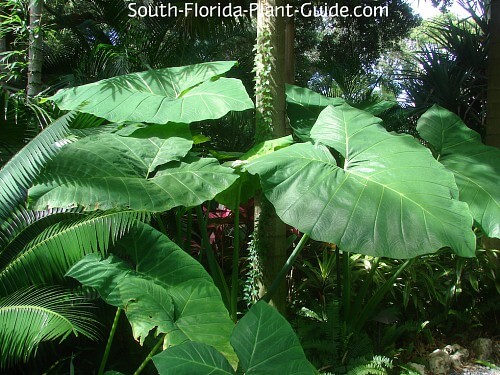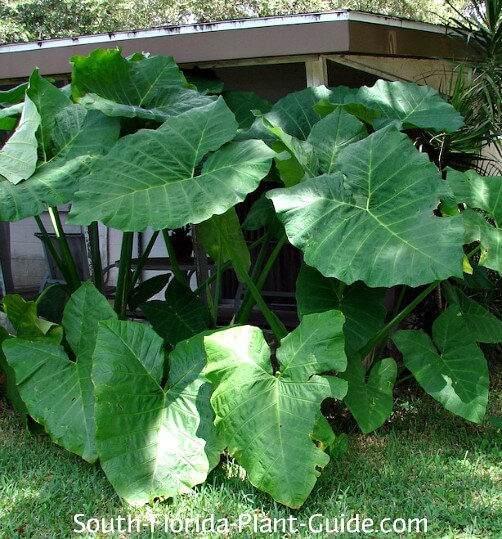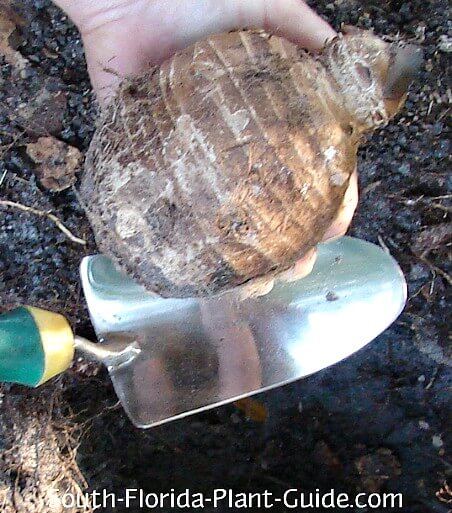Elephant Ears
Colocasia esculenta
One elephant ears plant - with its gigantic leaves and jungle look - is the ultimate in tropical in a South Florida landscape.

These plants are downright amazing in scope and fabulous as texture plants.
They'll grow in any light but seem happiest in part sun to part shade, growing very large and spreading as they mature.
This is a gorgeous addition to a tropical style landscape. Its enormous
size makes it an eye-catching centerpiece for a circular drive, a beautiful single specimen in the yard, or an exotic accent at the corner of the house.
Because of its immense size at maturity, it works best in large areas. Avoid placing one too close to other things that can be overwhelmed by this plant's huge mature size.
Let it make a statement all on its own or use it as a backdrop well away from the plants in front of it.
There is quite a bit of confusion over this plant's common name.
Many plants are called elephant ears - colocasia, alocasia, caladium and others - basically because of their similarities in large tropical leaves.
It's even more confusing than the many plants called jasmine just because they have white and/or fragrant flowers but few of which are actually true jasmines.
But colocasia esculenta is the true elephant ears, though the species comes in many forms...there are over 200 known cultivars with leaves in colors like purple or lime-green.
This plant is usually sold as an unattractive potato-like tuber (sometimes erroneously referred to as a bulb or corm).
After planting, as the leaves emerge quickly and the plant matures, spreading into a clump that can grow very wide and form new plants.
A colder winter in South Florida may cause dieback. But once warm weather returns in spring, new shoots should appear and grow back into a large plant by summer's end.
It's best to avoid placement near preserves and wetlands where this plant can grow wild and become invasive.
All parts of this plant are used as a food source in the Caribbean, South America, Asia and elsewhere.
If you've been to Hawaii, you may have tasted it.
Hawaiians call the plant "kalo" and their traditional dish known as "poi" is made from a mashed, cooked tuber.
Though they are related to plants like philodendron which do contain toxins, these plants are unlikely to hurt anyone - though needle-like crystals on the surface can cause skin irritations in some people.

Plant specs
This plant can reach about 5 or 6 feet (or more) in height, and the wide-spreading stems and new plants will create an overall width of 8 feet or more.
Rate of growth is fast, and any light is fine.
The more sun you give these plants, however, the more water they'll require.
Though considered cold hardy, elephant ear plants may die back a little or a lot in colder weather.
Generally,
though, growing it anywhere in South Florida's Zones 9B and 10 will
work with a minimum of cold damage...especially if you choose a
sheltered planting location out of the wind. (This also keeps the leaves
from shredding.)
Plant care
Add top soil (or organic peat humus) to the hole when planting.
Dig the hole a little deeper and twice as wide as the tuber's diameter.
Set the tuber upright in the hole and cover with about 4 inches of soil.

Trimming will be necessary only to remove spent leaves and stems on occasion.
Water is very important to the health of this plant - it needs regular irrigation to thrive.
Fertilize
3 times a year - in spring, summer, and autumn - with a good granular
fertilizer. You may want to supplement feedings with liquid fertilizer
during warm months.
Plant spacing
Plant tubers about 4 to 6 feet apart. Come out from the house at least 3 feet and in from walks and drives 4 feet or more.
Place these plants at least 4 feet - more if possible - from nearby small to medium sized plants. For planting near things that are or will be larger than this plant, allow about 3 or 4 feet.
Elephant ears will grow in a container for a while but does much better in the ground.
Landscape uses for elephant ears
- single yard specimen
- large accent for the corner of the house, deck or patio
- background for smaller plants
- filling the center of a circular drive
- to add height and interest along a blank wall
- around the trunk of a tree or palm
A.K.A. (also known as): Kalo, Taro
GOOD SNOWBIRD PLANT: MAYBE - in a large yard in Zone 10
COMPANION PLANT SUGGESTIONS: Nearby plants might include dioon edule, variegated arboricola, mini-leaf copper plant, thunbergia, and yellow elder.
Other plants you might like: Alocasia, Selloum Philodendron
Take a break!
The ultimate guide to low-maintenance plants
and landscaping!
An ebook by
Chase Landre
author of
South-Florida-Plant-Guide.com
Learn more!
Get a greener thumb!
Want to learn more about South Florida planting, watering, fertilizing and dealing with weeds and pests?
See our Gardening How-To section for answers!
Get instant curb appeal!
An ebook by
Chase Landre
author of
South-Florida-Plant-Guide.com
Learn how to get instant curb appeal with fast growing plants and landscaping techniques!


